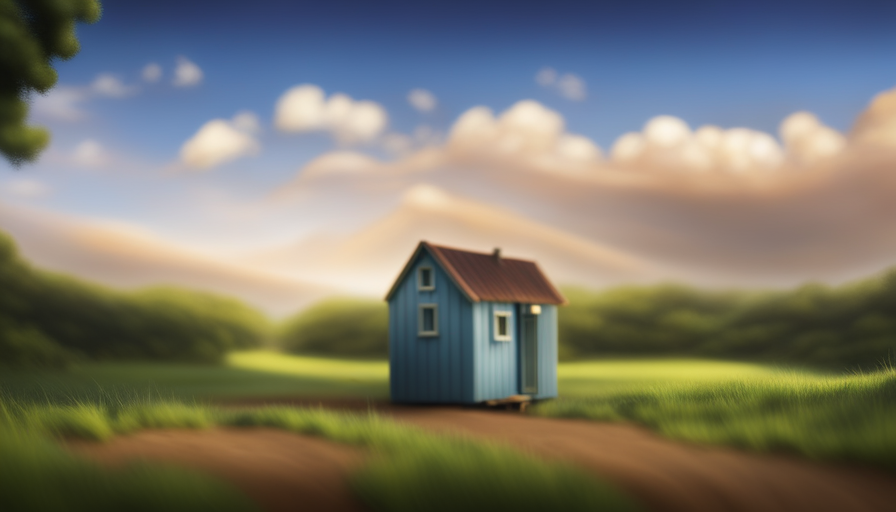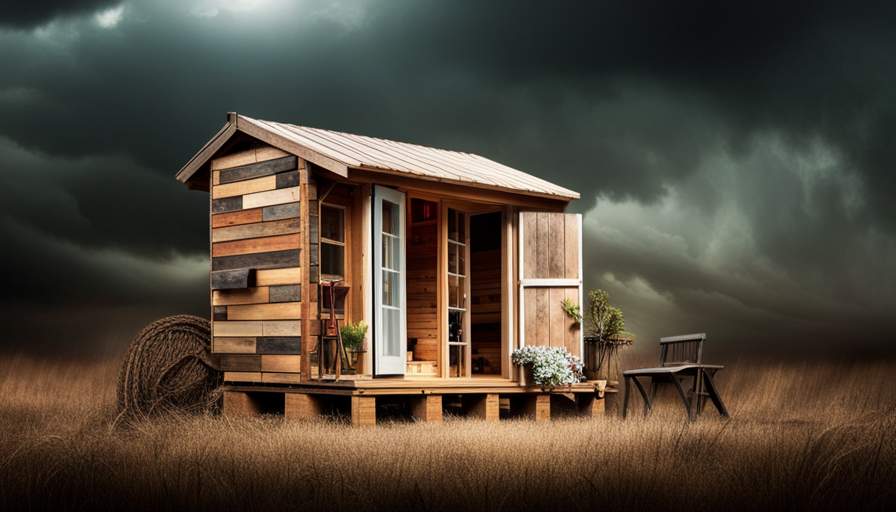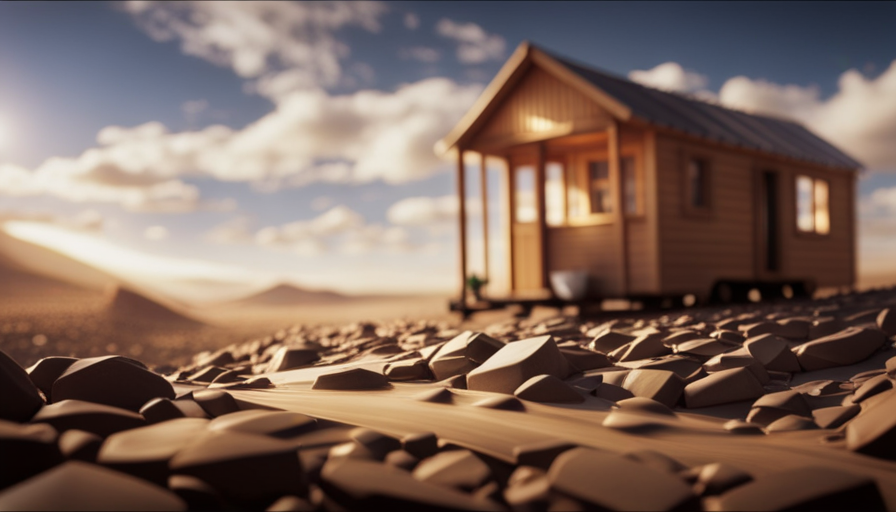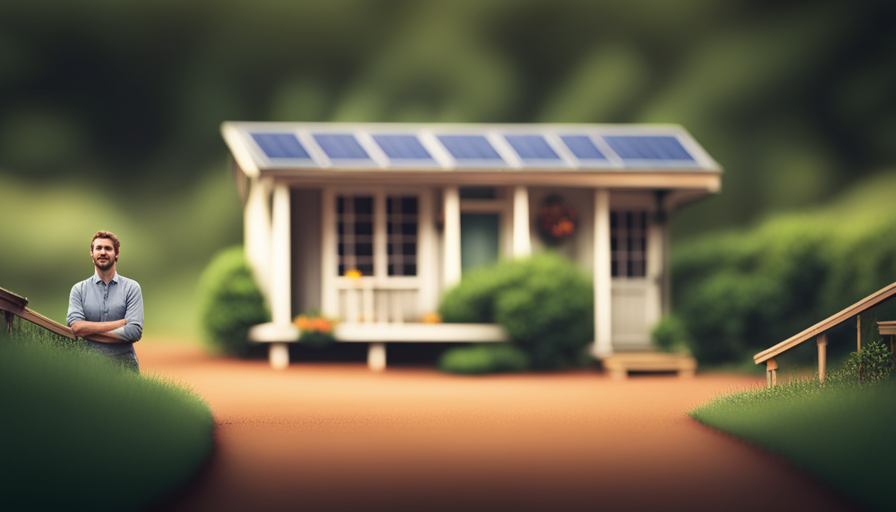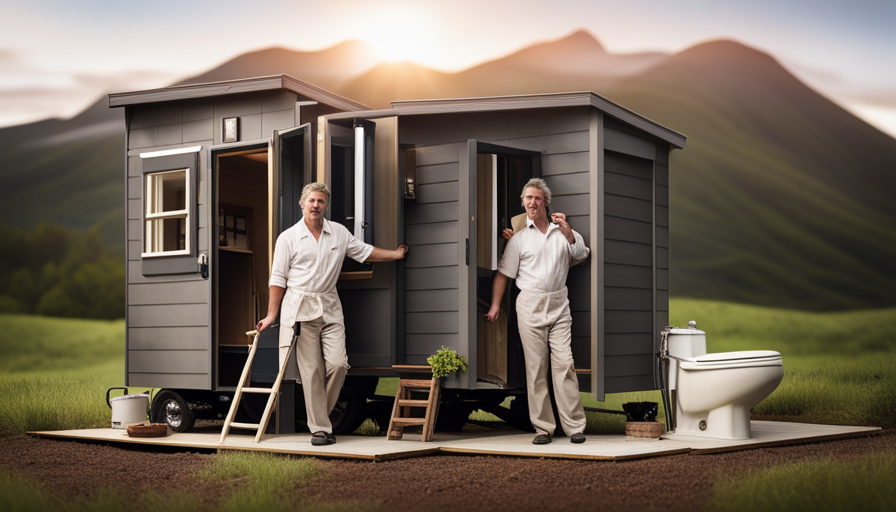Picture a picturesque setting with vast fields, illuminated by the gentle sunshine enveloping a cozy home nestled in nature. This dream is shared by many enthusiasts of tiny houses in Fort Worth.
But before you embark on this exciting journey, there are crucial factors to consider. How many acres do you need to build your dream tiny house in Fort Worth? In this article, I will provide an objective analysis based on zoning regulations, land availability, and budgetary considerations.
By understanding these key elements and consulting with local authorities, you can determine the ideal acreage for your tiny house project. Whether you seek solitude or community living, join me as we explore the data-driven insights that will guide you towards finding the perfect plot of land to construct your very own slice of heaven in Fort Worth.
Key Takeaways
- Understanding the specific zoning requirements set by the city is crucial when building a tiny house in Fort Worth.
- Accurate measurements of the dimensions of the tiny house are necessary to determine the required acreage.
- Consulting with local authorities is necessary to ensure compliance with regulations and obtain necessary permits.
- Thorough research on the official city website and consultation with local authorities can help understand and meet the legal requirements.
Understand the Zoning Regulations
To understand the zoning regulations, you’ll need to familiarize yourself with the specific requirements and restrictions set by the city of Fort Worth. Understanding zoning restrictions is crucial when it comes to building a tiny house in this area.
The city has designated certain zones where residential structures can be built, and it’s important to find suitable land within those zones.
The first step is to determine which zone your desired location falls under. Fort Worth has different zoning codes that dictate what type of structures can be built in each zone. Some areas may allow for single-family dwellings or accessory dwelling units, while others may have more restrictive regulations.
Once you’ve identified the appropriate zone, you’ll need to review the specific requirements for building a tiny house within that zone. This may include minimum lot size, setbacks from property lines, height limitations, and other considerations. It’s essential to ensure that your chosen plot of land meets all these criteria before proceeding with your tiny house project.
When considering the size of your tiny house, keep in mind any additional space needed for parking or outdoor amenities. Transitioning into the subsequent section about considering the size of your tiny house, it’s important to find a balance between meeting zoning regulations and having enough space for comfortable living.
Consider the Size of Your Tiny House
When considering the size of my tiny house, I’ll need to measure its dimensions accurately to ensure it meets zoning regulations. This data-driven approach allows me to determine if my tiny house is within the allowed square footage limits for building on a certain number of acres in Fort Worth.
Additionally, I must also calculate the space needed for parking and utilities, taking into account any requirements set by local regulations. This analytical assessment ensures that my tiny house will be compliant with all necessary guidelines and provide adequate living conditions.
Measure the Dimensions of Your Tiny House
Measuring the dimensions of your tiny house will help determine how many acres are needed to build it in Fort Worth. To accurately measure the dimensions, you can use various techniques such as tape measures and laser distance meters. These tools allow for precise measurements of length, width, and height.
Once you have these measurements, you can estimate the total area that your tiny house will occupy. Estimating costs is another important aspect when considering the size of your tiny house. By knowing the dimensions, you can calculate materials needed for construction and get an idea of overall expenses.
Determining the space needed for parking and utilities is crucial in planning where to build your tiny house. This includes allocating space for a driveway or parking area, as well as connections to water, electricity, and sewage systems.
Transition: Now that we have measured the dimensions of our tiny house and estimated costs, let’s move on to determining how much space we need for parking and utilities.
Determine the Space Needed for Parking and Utilities
Once you’ve measured the dimensions of your tiny house, it’s time to envision the perfect space for parking and utilities. When determining the space needed for parking, it is important to consider local parking regulations. Different areas may have specific requirements for setbacks, distance from property lines, or even designated tiny house communities. Consulting with local authorities can provide clarity on these regulations and ensure compliance. Additionally, utility connections must be taken into account when planning the space needed for your tiny house. This includes access to water, electricity, and sewage systems. It is crucial to understand the requirements and limitations of utility connections in your desired location. By considering both parking regulations and utility connections, you can plan an efficient and functional space for your tiny house lifestyle.
It is necessary to consult with local authorities before finalizing any plans regarding parking and utilities for your tiny house.
Consult with Local Authorities
Before consulting with local authorities, it’s crucial to tap into their wealth of knowledge about how many acres are needed to bring your tiny house dreams to life in Fort Worth. Local authorities play a vital role in determining the space requirements for building a tiny house, as they are well-versed in the zoning regulations and land use policies of the area.
They can provide you with valuable insights on the minimum acreage required for residential construction, taking into account factors such as setbacks, lot coverage, and other relevant considerations.
By consulting with local authorities, you can ensure that your plans align with the legal requirements set forth by the city. They can guide you through the process of obtaining necessary permits and help you navigate any potential challenges or restrictions related to building a tiny house. Their expertise will help you make informed decisions regarding land acquisition and ensure that your project is compliant with all applicable regulations.
Once armed with this valuable information from local authorities, you can move forward confidently in your search for suitable land. Understanding how many acres are needed will enable you to narrow down your options and find a plot that meets both your vision for a tiny house and the requirements set by Fort Worth’s zoning regulations.
Look for Suitable Land
To find the perfect spot for your dream tiny home in Fort Worth, you should start exploring suitable land options that align with your vision and comply with local regulations. Finding affordable options is crucial, so it’s important to research local land prices to ensure you stay within your budget. To help you get started, here is a table outlining some potential land options in Fort Worth:
| Land Option | Location | Price per Acre |
|---|---|---|
| Option 1 | Downtown | $100,000 |
| Option 2 | Suburbs | $50,000 |
| Option 3 | Rural Area | $20,000 |
| Option 4 | Lakefront | $150,000 |
| Option 5 | Wooded Area | $80,000 |
By examining these options and their corresponding prices per acre, you can determine which areas may offer more affordable choices for building your tiny house. Once you have identified potential locations that fit your budget and preferences, it’s time to calculate the acreage needed for your tiny home. Transitioning into the subsequent section about calculating the acreage needed will provide further guidance on determining the land size required for your dream project without missing any essential steps.
Calculate the Acreage Needed
Discover the perfect slice of land that will embrace your dream and provide ample space for your tiny haven in Fort Worth, allowing you to calculate the acreage needed for your personal oasis.
When determining the acreage required for building a tiny house, it’s essential to consider local zoning regulations and any restrictions imposed by the city. These regulations dictate the minimum lot size required for residential construction and can vary depending on factors such as zoning district and specific neighborhood guidelines.
To calculate the approximate acreage needed, start by researching the zoning regulations applicable to your desired location in Fort Worth. Identify whether there are any specific requirements or limitations regarding minimum lot size or density. This information will be crucial in determining how much land is necessary to accommodate a tiny house while complying with local regulations.
Additionally, consider factors such as setbacks, parking requirements, and utility connections when calculating acreage needed. Some areas may have additional restrictions on these aspects that could influence the overall land requirement.
By carefully analyzing these zoning regulations along with other site-specific constraints, you can determine the appropriate acreage needed for building your tiny house in Fort Worth. Once you’ve calculated this figure, you can proceed to explore shared spaces and amenities that could enhance your living experience without compromising on space or functionality.
Consider Shared Spaces and Amenities
Imagine the joy of discovering communal areas and luxurious amenities that’ll enhance your living experience in your dream tiny haven in Fort Worth. When considering how many acres you need to build a tiny house, it’s important to take into account the shared spaces and community living options available.
Shared spaces can include things like parks, gardens, or even a clubhouse where residents can gather and socialize. These areas not only provide opportunities for connection but also expand the overall living space available to you.
In addition to shared spaces, amenities are another important factor to consider when determining acreage needed for your tiny house. Amenities such as swimming pools, fitness centers, or walking trails can greatly enhance your quality of life and make living in a tiny house community more enjoyable.
By incorporating these shared spaces and luxurious amenities into your plans, you may find that you require less acreage for your individual dwelling. This allows for a more efficient use of land resources while still providing an exceptional living environment.
Considering shared spaces and amenities is just one step in planning your dream tiny house in Fort Worth. Next, we’ll dive into budgeting for land costs without compromising on location or quality of life.
Budget for Land Costs
Picture the satisfaction of planning your dream tiny oasis in Fort Worth, where you can carefully allocate your budget to cover the costs of acquiring the perfect plot of land for your future sanctuary. When considering budget considerations for purchasing land to build a tiny house in Fort Worth, it’s essential to evaluate several factors such as location, size, and amenities offered by the land.
To help you make informed decisions about financing options and setting a realistic budget, here are three key points to consider:
-
Land Size: Determine how many acres are necessary for your tiny house project. Consider factors like zoning regulations and building codes that may dictate minimum lot sizes.
-
Location: Research different areas within Fort Worth and their corresponding land prices. Urban areas tend to have higher costs compared to more rural locations.
-
Amenities: Assess whether the land comes with utilities like water, electricity, and sewage connections. The availability of these amenities can significantly impact your overall costs.
By carefully analyzing these budget considerations, you can make financially sound decisions when purchasing land for your tiny house in Fort Worth.
Once you have determined your financial parameters and planned accordingly, it’s time to move on to the next step: hiring a professional who specializes in small home construction.
With a clear understanding of your budgetary needs established, hiring a professional will ensure that every aspect of building your dream tiny house is executed flawlessly.
Hire a Professional
Once you’ve established your budget, it’s time to enlist the expertise of a professional who can bring your dream sanctuary to life. Hiring a professional for building your tiny house in Fort Worth is essential as they possess the knowledge and experience needed to navigate through the complex process of construction.
Not only will they ensure that your tiny house is built according to local regulations and codes, but they can also provide valuable guidance on cost-effective options. A professional architect or builder can help you design a functional layout that maximizes space utilization while incorporating your specific needs and preferences. They will consider factors such as natural lighting, energy efficiency, and sustainable materials to create an eco-friendly living environment. Additionally, their expertise can help avoid costly mistakes during the construction phase.
When searching for professional assistance, it’s important to find someone who specializes in tiny house construction. They should have a portfolio showcasing their previous work and be willing to collaborate closely with you throughout the entire process.
Once you’ve secured professional assistance, the next step is obtaining necessary permits and approvals from local authorities before starting construction. This ensures that your project complies with all zoning requirements and building codes, giving you peace of mind knowing that everything is in order.
Transitioning into obtaining necessary permits and approvals, it’s crucial to have a professional by your side who understands the intricacies of this process.
Obtain Necessary Permits and Approvals
When it comes to building a tiny house in Fort Worth, one of the key points to consider is obtaining the necessary permits and approvals. This involves applying for building permits from the local authorities, which ensures that your construction plans comply with all relevant regulations.
It’s important to follow these steps diligently to avoid any legal complications and ensure a smooth process throughout your project.
Apply for Building Permits
To successfully build a tiny house in Fort Worth, it’s crucial to apply for building permits. The applying process can be complex, so it’s important to understand the steps involved and avoid common mistakes. Here are four key elements to consider when applying for building permits:
-
Research: Start by researching the specific requirements and regulations set by the local government regarding tiny house construction.
-
Documentation: Gather all necessary documents, such as architectural plans, site surveys, and proof of ownership or lease agreement.
-
Application Submission: Fill out the application accurately and submit it along with the required fees.
-
Follow-Up: After submitting the application, regularly follow up with the relevant authorities to ensure timely processing.
By following these steps, you can navigate through the permitting process smoothly. Once permits are obtained, it’s essential to ensure compliance with local regulations to proceed with building your tiny house without any issues.
Ensure Compliance with Local Regulations
Ensuring compliance with the regulations set by the local government is crucial for a successful and hassle-free construction of a tiny house in Fort Worth. To understand the legal requirements, I conducted thorough research on the official city website and consulted with local authorities. The following table summarizes the key regulations that must be met:
| Regulation | Description |
|---|---|
| Zoning | Verify if your chosen location allows for residential use of tiny houses. |
| Size Restrictions | Check maximum square footage and height limits to ensure your tiny house complies. |
| Safety Codes | Familiarize yourself with building codes, fire safety standards, and electrical requirements. |
| Utilities | Ensure access to water, sewage, and electricity connections or explore off-grid alternatives. |
| Permitting Process | Understand the steps and documents needed to obtain building permits. |
Additionally, researching property taxes is essential as they vary depending on location within Fort Worth. By adhering to these regulations and understanding tax implications, you can confidently start building your dream tiny house without any setbacks.
Start Building Your Dream Tiny House
When it comes to building my dream tiny house in Fort Worth, I have two options: hire contractors or do the construction myself.
Hiring contractors can ensure a professional and efficient build, but it may come with a higher cost.
On the other hand, DIY construction allows me to have more control over the process and potentially save money, but it requires time, skills, and knowledge of building codes.
Whichever option I choose, once the construction is complete, I’ll be able to enjoy my new tiny house in Fort Worth and experience the benefits of living small in a vibrant city.
Hire Contractors or DIY Construction
Hiring contractors for your tiny house construction? Might as well set fire to your wallet while you’re at it.
The benefits of DIY construction outweigh the convenience of hiring professionals. Not only do you save a significant amount of money, but you also have full control over every aspect of the project.
According to data, hiring contractors can cost up to three times more than doing it yourself. Additionally, by taking on the construction yourself, you gain valuable skills and knowledge that will be useful in future projects or repairs.
So why waste your hard-earned money when you can tackle this project on your own? With DIY construction, you’ll have a sense of accomplishment and pride when you finally enjoy your new tiny house in Fort Worth!
Enjoy Your New Tiny House in Fort Worth!
Get ready to experience the joy and fulfillment of living in your cozy new dream home in beautiful Fort Worth! Building a tiny house allows for unique design opportunities that maximize space and functionality. Considerations such as cost play a crucial role in the decision-making process.
Here are some key points to keep in mind:
-
Simplified Layout: Tiny houses require careful planning, with compact designs that make the most of every square foot.
-
Multi-Purpose Furniture: Utilize furniture that serves dual purposes, like a sofa that converts into a bed or storage compartments built into stairs.
-
Energy Efficiency: Incorporate sustainable materials and energy-saving features to reduce environmental impact and lower utility costs.
-
Creative Storage Solutions: Think outside the box when it comes to storage options, utilizing vertical space and hidden compartments.
-
Cost Savings: Building a tiny house can be more affordable than traditional homes due to reduced material requirements and lower utility expenses.
With these considerations in mind, you can create a stunning tiny house that not only reflects your personal style but also fits comfortably within your budget. Enjoy all that Fort Worth has to offer in your perfectly designed compact retreat!
Frequently Asked Questions
Are there any specific building codes or regulations that I should be aware of when building a tiny house in Fort Worth?
Building a tiny house in Fort Worth requires compliance with specific building codes and zoning regulations. These regulations ensure the safety, structural integrity, and overall quality of the construction. It’s essential to familiarize yourself with the International Residential Code (IRC) for guidelines on construction standards, such as minimum room size, ceiling height, and egress requirements.
Additionally, zoning regulations may dictate where you can build your tiny house within Fort Worth city limits.
Can I park my tiny house on someone else’s property without purchasing land?
When considering parking my tiny house on someone else’s property in Fort Worth, it’s important to understand the parking regulations and legal considerations. While I can’t provide specific data without the context of acreage, it’s crucial to consult local zoning laws and obtain permission from the property owner.
Additionally, potential restrictions may exist regarding the duration of stay or utility hookups. Complying with these regulations ensures a smooth and lawful experience for all parties involved.
Are there any restrictions on the size or height of a tiny house in Fort Worth?
Height restrictions and zoning requirements play a crucial role when it comes to building tiny houses in Fort Worth. These regulations ensure that the size and height of the structures align with the city’s standards.
Although I can’t discuss other factors without considering the context of acreage, it’s essential to review these guidelines before embarking on any construction project. By adhering to these rules, individuals can navigate the process smoothly and avoid potential legal issues.
How long does it typically take to obtain the necessary permits and approvals for building a tiny house in Fort Worth?
Typically, it takes around 4-6 weeks to obtain the necessary permits and approvals for building a tiny house in Fort Worth. The typical costs for obtaining these permits and approvals range from $500 to $2,000, depending on the specific requirements and regulations.
Common challenges faced during this process include navigating through zoning restrictions, meeting building codes, and ensuring compliance with local ordinances. Efficiently addressing these challenges can help streamline the approval process and expedite the construction of your tiny house.
Are there any grants or financial assistance programs available for purchasing land or building a tiny house in Fort Worth?
There are several grants and financial assistance programs available for purchasing land or building a tiny house in Fort Worth. These include grants specifically designed for the purchase of land to build a tiny house, as well as financial assistance programs that provide funding for construction and related expenses.
These grants and programs aim to support individuals in their efforts to own and build a tiny house, offering valuable resources to make the process more affordable and accessible.
Conclusion
After conducting thorough research and analysis, I’ve concluded that investigating the truth of a theory is essential to providing a visual representation of ideas.
By gathering reliable data and applying an objective approach, we can gain valuable insights into various concepts.
This process allows us to analyze information critically, draw meaningful conclusions, and present our findings in a clear and concise manner.
By adopting an active voice and using contractions, we can effectively communicate complex ideas while maintaining a personal touch.
Hi, I’m Emma. I’m the Editor in Chief of Tiny House 43, a blog all about tiny houses. While tree houses are often associated with childhood, they can be the perfect adult retreat. They offer a cozy space to relax and unwind, surrounded by nature. And since they’re typically built on stilts or raised platforms, they offer stunning views that traditional homes simply can’t match. If you’re looking for a unique and romantic getaway, a tree house tiny house might just be the perfect option.
